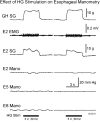Biomechanical effects of esophageal elongation on the circumferential tension of the cervical esophagus in vivo
- PMID: 36656979
- PMCID: PMC9970647
- DOI: 10.1152/japplphysiol.00667.2022
Biomechanical effects of esophageal elongation on the circumferential tension of the cervical esophagus in vivo
Abstract
Evidence obtained ex vivo suggests that physical elongation of the esophagus increases esophageal circumferential stress-strain ratio, but it is unknown whether this biomechanical effect alters esophageal function in vivo. We investigated the effects of physical or physiological elongation of the cervical esophagus on basal and active circumferential tension in vivo. The esophagus was elongated, using 29 decerebrate cats, either physically by distal physical extension of the esophagus or physiologically by stimulating the hypoglossal nerve, which activates laryngeal elevating muscles that elongate the esophagus. Hyoid, pharyngeal, and esophageal muscles were instrumented with electromyogram (EMG) electrodes and/or strain gauge force transducers. Esophageal intraluminal manometry was also recorded. We found that physical or physiological elongation of the cervical esophagus increased esophageal circumferential basal as well as active tension initiated by electrical stimulation of the pharyngo-esophageal nerve or the esophageal muscle directly, but did not increase esophageal intraluminal pressure or EMG activity. The esophageal circumferential response to the esophago-esophageal contractile reflex was increased by distal physical elongation, but not orad physiological elongation. We conclude that physical or physiological elongation of the esophagus significantly increases esophageal circumferential basal and active tension without muscle activation. We hypothesize that this effect is caused by an increase in esophageal stress-strain ratio by a biomechanical process, which increases circumferential wall stiffness. The increase in esophageal circumferential stiffness increases passive tension and the effectiveness of active tension. This increase in cervical esophageal circumferential stiffness may alter esophageal function.NEW & NOTEWORTHY Physical or physiological esophageal elongation increases esophageal circumferential active or passive tension by a biomechanical process, which causes a decrease in esophageal circumferential elasticity. This increased stiffness of the esophageal wall likely promotes esophageal bolus flow during various esophageal functions.
Keywords: circumferential wall tension; esophageal elongation; esophagus; stress-strain ratio.
Conflict of interest statement
No conflicts of interest, financial or otherwise, are declared by the authors.
Figures












Similar articles
-
Biomechanical increase in cervical esophageal wall tension during peristalsis.Am J Physiol Gastrointest Liver Physiol. 2024 Jun 1;326(6):G726-G735. doi: 10.1152/ajpgi.00049.2024. Epub 2024 Apr 16. Am J Physiol Gastrointest Liver Physiol. 2024. PMID: 38626405 Free PMC article.
-
A biomechanical response of the esophagus participates in swallowing.Am J Physiol Gastrointest Liver Physiol. 2023 Feb 1;324(2):G131-G141. doi: 10.1152/ajpgi.00219.2022. Epub 2022 Dec 13. Am J Physiol Gastrointest Liver Physiol. 2023. PMID: 36511513 Free PMC article.
-
Role of peripheral reflexes in the initiation of the esophageal phase of swallowing.Am J Physiol Gastrointest Liver Physiol. 2014 Apr 15;306(8):G728-37. doi: 10.1152/ajpgi.00411.2013. Epub 2014 Feb 20. Am J Physiol Gastrointest Liver Physiol. 2014. PMID: 24557762 Free PMC article.
-
Reflex-mediated enhancement of airway protective mechanisms.Am J Med. 2000 Mar 6;108 Suppl 4a:8S-14S. doi: 10.1016/s0002-9343(99)00289-2. Am J Med. 2000. PMID: 10718445 Review.
-
Functional anatomy and physiology of the upper esophageal sphincter.Am J Med. 2000 Mar 6;108 Suppl 4a:27S-37S. doi: 10.1016/s0002-9343(99)00337-x. Am J Med. 2000. PMID: 10718448 Review.
Cited by
-
Biomechanical increase in cervical esophageal wall tension during peristalsis.Am J Physiol Gastrointest Liver Physiol. 2024 Jun 1;326(6):G726-G735. doi: 10.1152/ajpgi.00049.2024. Epub 2024 Apr 16. Am J Physiol Gastrointest Liver Physiol. 2024. PMID: 38626405 Free PMC article.
-
Coordination of Pharyngeal and Esophageal Phases of Swallowing.J Neurogastroenterol Motil. 2024 Oct 30;30(4):397-406. doi: 10.5056/jnm24003. J Neurogastroenterol Motil. 2024. PMID: 39397618 Free PMC article. Review.
References
Publication types
MeSH terms
Grants and funding
LinkOut - more resources
Full Text Sources
Miscellaneous

